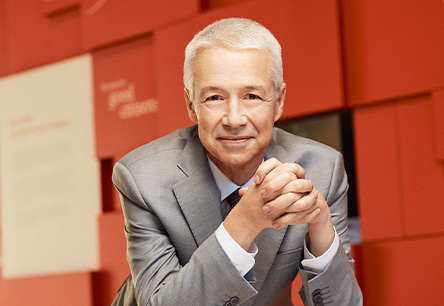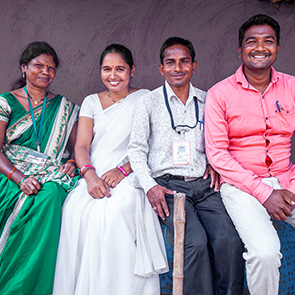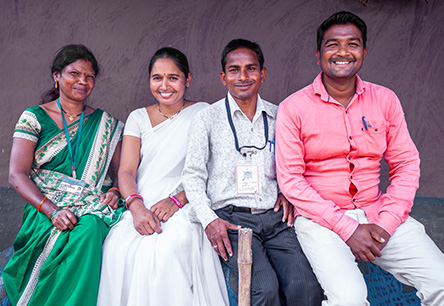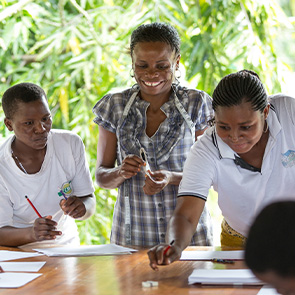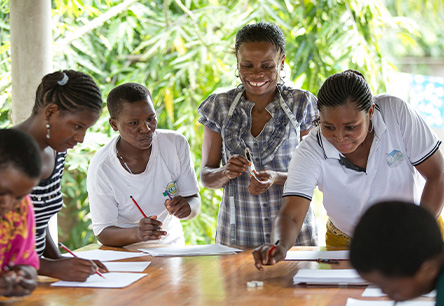We are committed to developing more sustainable products to support the health of people and our planet. We focus on the product categories, platforms and lifecycle areas with the highest potential impact and prioritize improvements that can be implemented across multiple products.
Product end-of-life and circularity
We recognize that the products we create may continue to have environmental impacts after use, and we are working to offer more end-of-life circular solutions. A selection of initiatives in 2022 include:
Expanding surgical device recycling
We expanded our hospital surgical device recycling program, which was piloted in Germany in 2021, to include eight countries in Europe. The program allows hospitals to recycle specific metal and plastic components from Ethicon and Biosense Webster’s single-use instruments while digitally capturing and communicating the environmental impact of salvaging materials such as steel, titanium, aluminum, copper and chrome steel, as well as specific plastics.59
Components from more than 25,000 single-use products were recycled in 2021 and 2022 through our Hospital Recycling Program.
The program is also expanding to recover Ethicon’s absorbable suture aluminum-based packaging in countries such as Germany and Switzerland.
Expanding pharmaceutical device take-back
We expanded our U.S. SAFE RETURNS program for home-administered Janssen immunology products to Switzerland. SAFE RETURNS allows patients to return their self-injectable devices using paper envelopes instead of plastic containers once used. A feature of the program is the removal of the hazardous material classification due to the needle-safe authorization, thereby eliminating the need for patients to prepare special paperwork for handling by mainstream postal services. The program is expected to expand to several additional European countries in 2023.
Addressing digital health device waste
Janssen launched and coordinated a new multiyear collaborative initiative, with co-funding through the EU Horizon Europe program, to address the issue of increasing digital health device waste. The initiative, called Digital Health in a Circular Economy (DiCE), brings together 20 organizations in the fields of manufacturing, research, refurbishing, remanufacturing, recycling, social science and policy from nine countries across Europe with an aim to examine the lifecycle of digital health devices from design to end of life, to help extend their lifetime and/or to responsibly manage them at the end of their useful life. Use of digital health devices is predicted to increase rapidly, so a collaborative solution is timely.
Reprocessing and recycling of medical devices
To reduce the end-of-life impact of medical device parts in the environment, J&J MedTech reprocessed, single-use devices manufactured by Johnson & Johnson company, Sterilmed, and also offers reprocessed products from other original manufacturers, in line with local laws.
In 2022, J&J MedTech in the U.S. and Canada:
medical devices
medical devices
Additionally, J&J MedTech’s Biosense Webster, in collaboration with Sterilmed, expanded its on-site support to collect reprocessable ultrasound catheters, diagnostic catheters and electrophysiology cables to maximize the reprocessing programs in Canada and the U.S. and help health systems support their environmental sustainability objectives.
Reducing medical e-waste

J&J MedTech’s Biosense Webster in Brazil implemented an initiative to help hospital staff understand how to change the practice of discarding single-use connector cables used in surgical ablation procedures by safely preparing them for reuse. Biosense Webster cables were designed with exclusive materials to perform in sterile conditions and, when properly sterilized, can be safely reused up to 10 times. By investing in educating hospital staff in sterilization procedures, tons of cables that are discarded annually in Brazil can now be avoided, both reducing waste and equipment expenses for hospitals.
Sustainable packaging
Across our diverse portfolio of products, we are working on multiple opportunities to improve the sustainability of our product packaging. A selection of initiatives in 2022 include:
Investing in new circular technologies
At Johnson & Johnson, we aim to work with suppliers attempting to find solutions to help divert waste from landfills and to develop technologies that turn diverted waste into new materials. This is why in 2022, Ethicon entered into an agreement with Eastman to purchase Eastman’s Eastar™ Renew 6763 copolyester for its medical device trays. Eastman is a global specialty materials company that produces a broad range of advanced materials, chemicals and fibers found in items people use every day.
By purchasing Eastman’s Eastar Renew 6763 copolyester, Ethicon is able to attribute a portion of the weight of each tray to materials that Eastman collects for recycling. With each tray, Ethicon helps divert waste from landfills and advances new technology solutions such as Eastman’s molecular recycling technology. We know that a collective approach is essential to tackle today’s greatest environmental challenges. This is an important first step toward advancing the circularity of our healthcare packaging.
Using recycled packaging for medical devices
J&J MedTech company DePuy Synthes launched more than 250 product items in the SYNFIX Evolution brand in post-consumer recycled (PCR) paperboard material (93%). This PCR packaging replaced white boxes made with 100% virgin paperboard. The new packaging went through extensive testing to confirm that it stands up to our stringent standards for sterility and structural integrity.
Reducing and recycling contact lens waste
As part of a commitment to reduce its environmental footprint, Johnson & Johnson Vision removed the plastic pouches on the outside of delivery boxes for all ACUVUE contact lenses in Europe. This change, involving placing delivery notes inside orders without external packaging, will save tons of plastic across Europe every year.
In the UK, Johnson & Johnson Vision’s ACUVUE Contact Lens Recycle Scheme, launched in 2019, has collected over 8.7 million lenses and recently expanded to increase capacity of lenses, blister packs and foils to be recycled each year. ACUVUE offers the only contact lens recycling program in the UK, and its expansion was achieved through an agreement with TerraCycle, with Johnson & Johnson Vision funding 3,500 Zero Waste Boxes in 2022 alone. Zero Waste Boxes are distributed to partnering opticians’ stores to provide nationwide access to contact lens recycling for consumers, providing a simple, accessible solution for storing, shipping and recycling contact lens waste, including the lenses themselves, along with the original foil covers and blister packaging.
Between 2019 and 2022, Johnson & Johnson Vision’s ACUVUE Contact Lens Recycle Scheme recycled more than 8 million pairs of contact lenses, blister packs and foils.
Collaborations on sustainable product and packaging
We are members of several organizations that promote sustainable packaging and circularity in our industry, including: The Healthcare Plastics Recycling Council, advancing plastics recyclability in healthcare; The Sustainable Healthcare Coalition, a healthcare sector-led group that inspires sustainable practices in healthcare; and The European Federation of Pharmaceutical Industries and Associations (EFPIA), which advances the transition to a circular economy across the pharma value chain as a key pillar of its activity.
Green chemistry and technology
Our R&D teams continue to integrate principles of green chemistry and engineering to develop our medicines. In 2022, progress included:
- Janssen obtained FDA approval for our inline conditioning process installed at Janssen’s Ireland facility. This process, already approved by the Ireland Health Products Regulatory Authority, was developed by the Janssen R&D team as part of a new manufacturing installation to support a plant expansion. Inline conditioning applies a unique approach to preparing, supplying and releasing solutions in real time to the manufacturing process, without the need for large-scale storage capacity. The traditional, manual batch approach to making buffers involves dissolving buffer components in large tanks filled with water and then, in some cases, transferring the solution into bags that are transported to the point of use. Inline conditioning both saves time and reduces material, waste and energy use throughout the process.
- Janssen improved the efficiency of the manufacturing process of an oligonucleotide API. The API manufacturing process is highly complex and can involve more than 100 linear chemical steps, consuming high quantities of solvents and reagents. Expanded process development and deep understanding of each chemical transformation and its engineering parameters upon scale-up reduced the manufacturing process mass intensity, which resulted in halving the API manufacturing cycle time, as well as lowering manufacturing costs. Without these significant process and yield improvements, patient access to this innovative medicine would have been restrictive both in terms of affordability, as well as annual manufacturing capacity.
- Upstream and downstream process improvements in the manufacturing of REMICADE (infliximab) enabled a significant increase in batch yield, thereby improving the product’s environmental profile. The new REMICADE manufacturing process enables a significant reduction in required batches to deliver the final product, thereby lowering the quantities of raw materials to deliver the same output.
Pharmaceuticals in the environment (PIE)
We play an important role in supporting initiatives to reduce the potential impact of pharmaceuticals and personal care products in the environment. We have a mature and robust program for managing PIE and our position can be found here.
Progress in 2022 included:
- We continued our active participation in the industry-led Eco-Pharmaco-Stewardship program, which released the Responsible Manufacturing Effluent Technical Guidance document, used by the industry and Johnson & Johnson to inform how we control the concentrations of APIs that may enter the environment from our manufacturing plants and those of our suppliers.
- As a member of the Antimicrobial Resistance Industry Alliance (AMRIA), we contributed to the publication of the AMRIA Antibiotic Manufacturing Standard: “Minimizing risk of developing antibiotic resistance and aquatic ecotoxicity in the environment resulting from the manufacturing of human antibiotics.”
- We also joined the Innovative Medicines Initiative’s Prioritization and Risk Evaluation of Medicines in the Environment (PREMIER) project consortium, which brings together public and private sector organizations to proactively manage the potential environmental impact of medicines. The initiative aims to design a novel information and assessment system for identifying and addressing environmental risks of medicines to support a new European standard for environmental protection.
59 Recycling varies by country.


